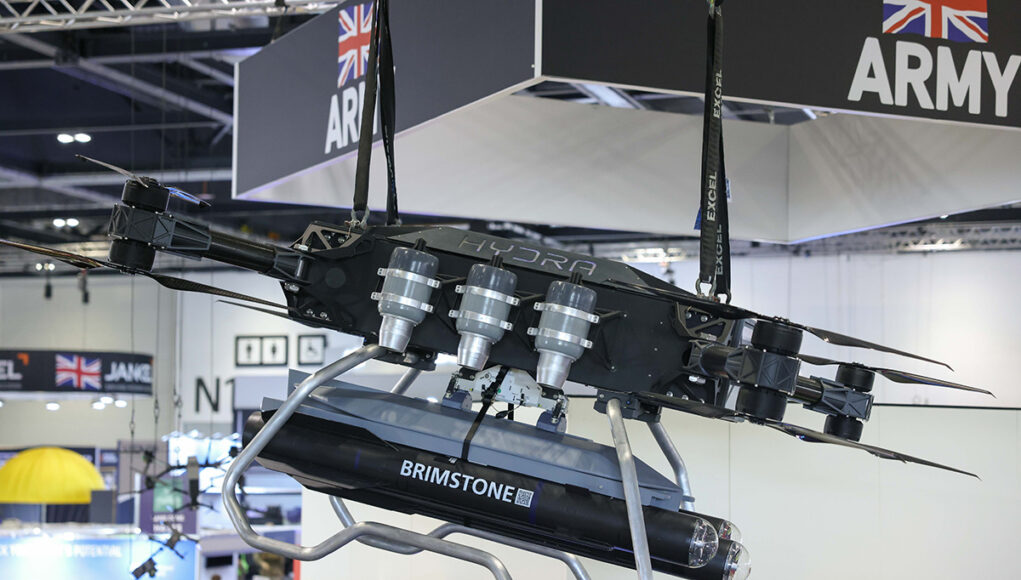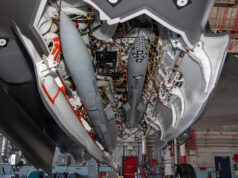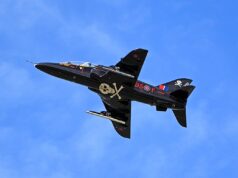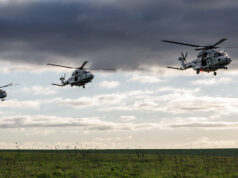A drone that fires laser-guided Brimstone missiles has been shown off at DSEI by the British Army.
The Hydra 400 is a new generation of heavy-lift drone using hybrid propulsion technology.
Compact and portable, the drone can be transported in the back of a Hilux or similar and assembled ready for flight in six minutes.
The drone is powered by single spool jet turbines, producing 500N (50kg) thrust providing a maximum lift of 400kg.
Ministry of Defence (MoD) funding will be needed for Hydra Drones Ltd, the company that developed Hydra 400, to progress the concept. It is proposed that the Hydra 400 carry a lethal payload, the Brimstone missile developed by Stevenage-based MBDA, which is the strategic partner to the MoD for complex weapons
The Brimstone missile weighs 50kg, is 1.8 metres in length and has a 180mm diameter. It is guided by millimetric wave radar and semi-active laser.
Brimstone offers ‘one missile, multi-platform’ versatility and is designed to be integrated onto helicopters, fixed wing aircraft, including fast jets, land vehicles, naval platforms and unmanned aerial vehicles (UAVs). The missile is battle proven with over 98% success rate in defeating static, moving and manoeuvring target sets including main battle tanks and other armoured vehicles.
General Sir Patrick Sanders, Army Chief of the General Staff, says:
“We are responding to the operating environment that we see in Ukraine. For example, I am struck by the fact that in the evolving Ukraine drone campaign, 40% of losses are attributed to pilot error. When the electro-magnetic spectrum is so heavily contested, automation fails, and the skill of the pilot predominates.
We need ‘war fighters’ – whether they are cyber specialist, drone pilots or infantry soldiers – to be stronger, faster, more intelligent and more resilient. By the end of this year, we will form a new UAS Group within a reorientated Joint Aviation Command, providing a focal point for industry, around which we intend to develop the next generation of UAS platforms in ever closer partnership.”














That’s a proper “Frankendrone”! Six gas turbines plus what looks like four contrarotating props! It must eat fuel/power.
Getting Brimstone downrange is always a great idea, but I would have thought a track mounted system with mast mounted optics is a better, more robust option.
Multi rotors are not efficient, and as you need to lung it around of a pickup truck why not used a fixed wing air frame which would be more efficient. Yes you need to solve recovery but that no a hung problem.
Cost wise, 6 turbine is likely to to cost around 15-18k alone even before considering the rest of the airframe costs.
Agree but the Ukraine conflict has shown drones are definitely the future for anti armour applications. Both sides are using thousands of cheap disposable drones a day. If and it’s a big if. This UAV can deliver 3 Brimstone missiles in a robust and reusable airframe then great.
It’s going to be cheaper then risking a £50+ million Apache E
The drones Ukraine are using are sub £2000 many sub £1000 adapter to carry cheap but effective munitions, I would expect this thing will have a price tag on 100k plus. Not saying this is not a good ideal and the concept of using drone to launch missiles is sound and as you say better than risking a more expensive airframe.
Yes, I build FPV long range drones in my spare time, both fixed wing and multi rotor. I’m a Cyber Security Engineer, and ex Pilot. I’ve been watching what Ukraine are building and using with a very keen interest. I’ve noticed they are using the same parts that I use. I suspect they are also using INAV open source software on some drones. Most cost less than £500 to build. Some perhaps less than £200. The transmitter and goggles are extra.
By the time you’ve added the extra MOD requirements, even a basic robust £30K quadcopter works up to £100K, especially if purchased in small numbers. A secure radio to be carried by a drone might cost nearly £20K all by itself. Do we throw out robustness, if it doesn’t work there will be plenty more that will? If it can’t fly in the rain, we’ll set them going after the rain stops? Do we say the heck with hackability, we need cheap and in quantity, and if the enemy hack a couple, well there are eight more on their way?
At what point do we say this is not attritable, it’s disposable, and we buy a spec with that in mind?
Yup, an engineering nightmare. Just an expensive; ‘see, look what we could build if we were daft enough’
Just strap a couple of Brimstones on the backpack!
https://bharatshakti.in/wp-content/uploads/2023/03/indian_army_jetpack_getty_2-sixteen_nine.jpg
It’s a good idea. This kind of tech can also be built quickly when required. Having basic components then adding with plug and play operating systems as required will really speed things up and get forces what they need for different missions.
Perhaps cheaper weapons need to be developed. Starstreak darts are ideal for cheaper effective weapons. Anything going supersonic is going to make a mess as it hits.
Anti personnel weapons are needed if the U.K. forces are going to be smaller than an opposing force. With cluster munitions out and mines some smart thinking is needed to answer how to take out 100s of enemy soldiers before they are in rifle range.
2 of these on the roof of each Boxer and we are in business
would that not be cheaper than standalone assets.
assuming there is room on the roof once the sensible decision to put a CTA40 turret on a vehicle that costs at least £4m a copy is taken..
I think some of the Boxer will have a Javelin on the RWS.
I have read of a requirement to finally replace Swingfire/Striker combo with an “overwatch” vehicle, probably Boxer, with Brimstone.
I’m a bit confused by the specs. If the turbines produce 50kg of thrust and there are (it appears) six of them, then that gives 300 kg of thrust. Do the rotors make up the >100 kg difference?
And how much thrust does 1 brimstone produce ? To keep the platform steady when firing just wondering
Do the brimstone thruster ignite after leaving the drone?
Must do. There are 8 rotors so there will be a substantial lift capacity
Bae were developing a rotor based quad copter with Brimstone late last year (though have heard nothing of late) and then there were those tests months back with a quad firing Martlet so the concept seems popular. I am no expert here but if Apache is expected to fundamentally pop up out of cover, locate, acquire and fire it’s missiles at a target(s) before hiding again beneath tree level (simplification I accept) then surely a drone of this nature has great potential in a similar but wider use model by front line troops giving Brimstones (or indeed other missiles) a clear launch point above an otherwise very concealed position. Far better than fixed wing in this mode methinks especially in defensive positions. The Ukranians used ‘spotters’* so they claim today to help guide and correct storm shadow strikes against the landing ship and submarine a few days back in Crimea so providing required info for this sort of drone to be effective by comparison would seem like Childs play right down special forces alley methinks.
*delivered to Crimea by semi submersible vehicles it seems, now where have I seen and heard that concept expressed before.
Why do we always overcomplicate systems rather than build a simple cheap drone we go for more sophistication and expense then wonder why nobody will buy it it in numbers. Looking at the use of drones in Ukraien 6 minutes could be be a very long time . Whats the range of this sysem what the recovery/refuel time? do we really need hybred propulsion ? given the jet engines it must be a great infra red target. It looks like a solution dreamed up in a lab looking for a problem.
, I guess this type of kit is more battalion level . And saves risking an apache or typhoon jet right on the front line . If this gets lost its not a massive loss compared to apache pilots. Infact it could speed up assistance for front line units if this kit is issued to army battalion and not air force or army aircorp me thinks
Watching a vid on the future force concept they might well be issued at Company rather than Bn level.
Absolutely, this gives a far wider potential and flexibility for taking on armoured vehicles and other targets quicker and safer than calling in air cover while potentially offering a better more survivable platform than something like Boxer that has to operate in a more open and discoverable environment to be effective. I read briefly a comment probably on Ukranian Pravda that the initial use of the early version Brimstone from those utility vehicles presented problems in acquiring targets, though it didn’t go into detail as to the exact problem which was frustrating. This sort of platform seems to offer real utility to only reveal itself when targets are known while not giving away the location of those operating it and the opportunity to scoot only minutes after releasing its load. Great potential flexibility without having to risk the drone itself operating close to the enemy it’s targeting.
I agree, it too complex, using two different methods of producing lift/thrust. In engineering, the keep it simple stupid philosophy is something I have always prescribed to. I see what they are trying to do, but there are better and more efficient ways of completing the same task, especially if you require a vertical take-off and landing platform. Something like the Schiebel Camcopter S-100 would be a better choice as a foundation. In its current configuration, it can lift 50kg, which is a lot less than the Hydra 400. But, with a more powerful engine and a three or four bladed rotor head you could significantly increase its payload. Which would cut down on its 6 hour endurance to probably 4 hours. But it would still be more efficient than the Hydra.
Something like the Schiebel with development, would I think be very useful armed with Brimstone or Martlet or whatever esp at Sea, but I think it’s role is quite different in essence to what is envisaged for a platform like Hydra. Both have their strengths and weakness I feel but we are very much thinking conceptually at the moment and only experience will show what use scenarios are best served by these differently emphasised technological skillsets. Room for both I suspect and others too no doubt. When you have a guy flying around with 4 small turbojets claiming that concept could be useful for para medics as well as military purposes, I won’t write off a concept like this using 6 that seems to be on the face of it far more practical and far less dangerous to the user and in the end far less complex than an Apache, F35 or Typhoon and far more expendable so worth at least trialing it.
I wont disagree, just saying there’s a more efficient way of lifting a payload, than the method the Hydra uses. Especially as they are using micro turbojets, rather than a turbofan. At the heights this platform is going to be used at, a turbofan can produce 30% more thrust (depending on the fan diameter and bypass ratio).
A tri-pack of Brimstone is 150kg and the launcher may add another 30kg. Which is over the payload limit of a basic S-100 or AWHero 200kg class helicopter UAV. The six micro-turbojets allow the Hydra to lift this kind of payload.
The next class of helicopter style UAV is 500kg to 2000kg. Which is a massive leap in overall size. This class includes the MQ-8B Firescout, which can carry a payload of 320kg.
For something like the S-100, to increase its payload capacity and keep the overall footprint of the aircraft. One of a number of options is to increase the number of blades from three to four/five on the main rotor head. Another option would be to make the aircraft co-axial (like a mini Ka-52). This will dramatically increase its potential payload capacity. Either options will need a more powerful engine to power more blades or two sets of rotor heads. You could also do as per Hydra and fit a number of supplementary turbojets for generating lift. But if the main rotor blades can’t develop enough lift in forward flight, then these will have to run continuously, which will kill endurance.
One key benefit the Hydra has over a helicopter is that the platform is a lot more stable. Which is good for when trying to land on a ship at sea.
Don’t agree, horses for courses, it won’t be used like the sort of drones you are imagining it would be used instead of an Apache I suspect. Whether jet or another power source is better is the most debatable aspect but the concept is sound. Brimstone launched from the ground has limitations of line of sight whatever it’s clever sensors. Give it a clear view above the ground and it solves a lot of problems while it will be detectable only for a short time and difficult to take out if it exploits trees and other cover. No doubt other smaller drones will be used for first seeking out potential targets. I think a whole range of drone types will become the norm over the next decade and will compliment each other.
That is a hell of a piece of kit, would give any opposing force an absolute nightmare
What excites me here , well a bit is that the uk will create a new drone type group separate from others . This is a good first step .
Modelling uk infantry battalions to ukrainian infantry battalions specifically for how they integrate there drone units , I guess should be done ASAP in next 12 months
We should deploy these in significant numbers, a true battlefield game changer.
Sorry although I love the engineering and potential for this as a load bearer I just think it is just plain wrong as a concept.
It carries 2 Brimstone missiles so the payload costs @£350 K and is vulnerable to just about anything from a Manpad to a heavy machine gun.
Now if someone was going to offer up a lightweight, cheap, modular drone capable of carrying laser designators or various other sensors to maximise Brimstones ground launched targeting or recce I’d be impressed.
Poland is buying Brimstone and mounting them on light wheeled and heavy tracked tank destroyers for anti tank use.
We have developed a version of Boxer to carry 8 Brimstones for just that purpose. Match that with a few targeting drones and you will really spoil someone’s day.
IMHO MOD needs to be very careful about which conclusions it draws from the present conflict. Yes you need high end weapon systems especially for long range strike but when it comes to ground warfare, simple solutions delivered en masse seems to prevail.
And for those who are of an engineering background they will know what KISS stands for 🤔
Agree w/ your assessment re this design. Next several years will result in a veritable fountain of combinations/permutations of design features. Wonder whether NATO is giving any consideration to looping the UKR into OT&E trials? In reality, they are enroute to become the free world’s operations experts As long as there is a reliable self-destruct feature security concerns should be minimized re trials in theater. UKR feedback could be as varied and direct as ‘thanks but no thanks’ to ‘we need 100K, the day before yesterday; why haven’t you delivered them already.’ 🤔😉
I do agree, my first move would be to present this concept as with the two other we know of, of a similar nature being prototyped and get their response and advice. At the moment they are using either light attack drones directly over targets or artillery to take it on at distance that is not easily concealed and has to scoot and represent a pretty big and discernible target as it does so. If this concept has legs and I find it difficult to believe it doesn’t, but the Ukranians will know best, it offers potential advantages over both the others in many instances and having seen a documentary on just how difficult it is to even see let alone take out a drone at even a 3 mile distance this lethal stand off platform that has a clear line of sight to the target unlike a land based system which can only extend range too. Working with the sort of targeting drones ABCRodney mentions I see distinct advantages over a land locked system. I am positive that Ukranians are providing all manner of feedback by the way and post war I bet their expertise will be crucial to weapon systems of this nature. Indeed the fact that 3 of this type of system seem to be being examined in the UK alone makes me think feedback has already occurred on such a concept.
This is sort of what Ukraine are doing with their MBTs. The are using the drones combined with MBTs as a hunter-killer team. They have been using the small quad copter drones controlled by infantry units to scout out areas for either their attached MBTs or for artillery support. Their have also been concepts of drones tethered to reconnaissance vehicles and MBTs. Which may be another route to take.
Looks like a pop up mobile fires type platform. Drive along a dirt track. Launch the drone above the canope of the woods, fire off a couple of brimstones then scoot. Sort of like the Apache philosophy isn’t it. Hide below the Hillcrest or tree line popup, take a look, fire then hide again.
Thats exactly how I see them being used . Treeline or urban areas pop up above or to the side of large buildings . The potential for this type of small flying vehicle firing brimstone , javelin, nlaw type stuff is an undeveloped niche so far for drones industries , and I reckons will be very successful
At last someone who gets it. This is its base role clearly, where it goes from there would no doubt spring from actual experience, but what’s the latest range of the Brimstone 2 or later 3, 20 miles plus air launched? So not sure it will be too susceptible to Manpads or other weapons unless the operators stray into contested areas they weren’t expecting and without being initially fired upon as they do so. Even then operating in and around the tree line it’s going to be difficult to target. I think too many see it being used in the same way as an attack or recon drone, but why do that when it’s carrying Brimstones with substantial range.
Is this not just a concept to prove it can be done?…
Think mbda knows better than armchair generals?.
Exactly these concepts need to be tested certainly seems at least as effective potentially as taking a Boxer into an open environment so it can fire it’s missiles or even whatever gun it’s carrying in the demonstrations we have seen by the makers. And far more expendable and flexible if operated off of a SuperCat or similar platform.
Quite alarming that we would lose 40% of the drones (Gen Sanders’ comment) before they achieved their mission through pilot error – and then some more from enemy action.
Yes read some commentary direct from Ukranian operators who explain just how difficult it is to control an Attack drone while engaging a moving target in particular. Letting Brimstone do the hard work and with a more effective warhead when it hits is certainly likely to be damn useful with higher end targets in mind at least.